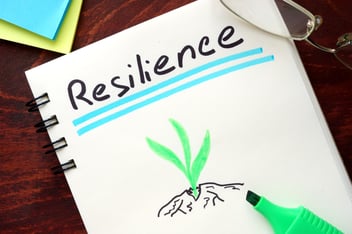
Few would dispute the need for innovation; in fact, most organizations identify innovation as a key business strategy. But the question of how to innovate in business is something that comes down to bringing clarity to who, what, where, when and why you want to innovate. And, if you're innovating through a crisis or dynamic situation, this blog shares ten tips to help you through.
How to innovate in business
How you innovate depends on what you want to achieve and the context in which you’re doing business. And it also depends on who you want to be involved in doing the innovation.
First, let’s clarify - what is innovation?
Innovation is what allows organizations to stimulate and transform new ideas and knowledge into products, processes or services that tangibly increase value to customers, accelerate business growth, enhance operational effectiveness or improve profitability[1].
Here are some basic questions that need consideration to answer how to innovate in business. Answering these questions will help you clarify your best strategy for moving forward.
Why do you want to innovate?
If you look at the definition of innovation above, you’ll notice it has a target, and the outcome is value creation. Without clarity on what that looks like for you, it will be challenging to measure results.
What is the focus of your innovation?
Are you looking to innovate to create new products or services for your customers, or are you focused on incremental improvements of existing ones? Or maybe your focus is on innovating your business – developing a new business model, pivoting a current strategy, developing new processes, or adding new technologies to support your operations or profitability.
Where will you innovate?
Are you innovating across the organization? In one geographical area? Off-site, away from everyone else?
Who will be responsible for innovation?
Do you want everyone in your organization responsible for innovation, or are you giving that responsibility to a select few? Are you setting up an innovation team, or running a project or research and development initiative? Or maybe you want to build a culture of innovation so that everyone engages in continuous improvement of operations and customer service. Who is responsible for innovation has a significant impact on how you innovate.
How will you lead innovation
Now that we’ve got all those other questions out of the way let’s look at how.
Often leaders tell me they know they need to innovate, and what they want to do. What they don’t have clarity on is how they will innovate and how they will lead it. And this is what makes all the difference to your success.
Here are some of the how questions to consider:
- How are you defining innovation?
- How will you lead and manage it?
- How do you plan to fund it?
- How will you do innovation?
- How do you plan to get good at it?
These might seem like simple enough questions to answer; however, we find many organizations think how is about choosing to use design thinking, agile or lean startup. How is more about how you will creatively think through the inevitable problems that will come up – particularly the ones that come with trying to change things everyone else in the organization wants to stay the same.
Innovation is a matter of time
There’s one final question that needs answering.
When? When will you innovate?
You could look at when you innovate through many lenses. When could be how often you want innovation to happen, as in, do you want people in your company focused on innovation all the time or only some of the time?
But a more frequent decision point around when to innovate is when you’re facing dynamic situations. We work with many leaders who ask us for help when they find themselves in what is becoming more commonly known as VUCA situations. Volatile, Uncertain, Complex, Ambiguous.
These are circumstances where things are changing, there’s uncertainty around outcomes, and you lack clarity around what to do or how to do it. These are the kinds of situations that leave you wondering – what do you do when you don’t know what to do or how to do it? These are times when you typically find yourself in new territory, charting new ground and needing to solve problems the likes of which you haven’t seen before.
When you’re in these kinds of situations, the need for innovation is all the more apparent. You need new thinking and new ways to solve problems so you can find innovative solutions to the challenges you face. When this happens, you need the confidence that you can lead through any situation, so you won’t find yourself stuck and unable to advance your goals.
Ten Tips on How to Innovate in Business through Dynamic Times
Here are ten tips on how to innovate in business when you’re working in dynamic situations:
1. Solve problems with your team
Bring your team together to help you find the right questions to ask and better answers. As a business leader, you don’t have all the answers in situations like this, nor should you. Innovation is a team sport that needs multiple skillsets and perspectives.
2. Be deliberately creative
Creativity fuels innovation. It’s a creative, collaborative process. In essence, it’s about using creative thinking and problem solving to advance your goals. Over the past ten years, we’ve been able to show our clients how to benefit from applied research that shows individuals have preferences for engaging in the creative process, as do teams and functions in organizations. When teams involved in innovation understand this and know how to use the creative process to organize their thinking and problem solving, they outperform teams who don’t.
3. Challenge your assumptions
Have the courage to challenge your assumptions about who, what, where, when, why, and how you are in business. Think about what becomes possible because of these circumstances. What’s now acceptable to you or your customers that you didn’t think would be in the past? What are you willing to do now that you didn’t want to consider before? Of course, be ethical in your decisions, but when you challenge your assumptions, especially when the game has changed, it’s surprising what opens up.
4. Let go to evolve
Be willing to let go of what you thought your business would be or should be. In dynamic situations, your business will need to evolve. Remember why you’re in business. Your “why” likely hasn’t changed – it’s what drives your purpose for being in business in the first place. What you do may or may not be changing; however, you may find you need to look at what you do differently. Maybe your business model needs to evolve, or perhaps how you do your work needs to change. It’s essential to look at what you do from different perspectives – that’s where you’ll find the opportunities for growth, learning and creating new value.
5. Focus on value
Innovation is about value creation, and we can’t do it in a vacuum. We need to talk with our customers. If you think in terms of the value you bring, the way that life can be better for your customers because of what you do, or what becomes possible because of changing circumstances, you’ll be able to adapt and stay relevant.
6. Appreciate what you’ve done
As you figure out how to move forward, no matter how small each step, move with gratitude for what you’ve already accomplished, built and learned.
7. Focus on what’s thriving
As you evolve your business, there will be many times where you will feel frustrated, discouraged and challenged by the effort it takes. You may even find yourself wondering if you’ll achieve the results you want. When you’re innovating through uncertain and ambiguous situations, you can and should set goals to keep momentum, but remember, you can’t control timelines to results. Things emerge and unfold differently. There are opportunities in obstacles. Your job is to find them by assessing and making choices based on what unfolds. Focus on what’s thriving and what you’re learning, not what’s not happening fast enough.
8. Arrange the pieces differently
When we’re evolving what we do, we need to build on what we’ve done. The goal is to arrange the pieces differently, to find new footing, to keep open and on the look-out for new opportunities. You won’t find them in the past. You will need to look with fresh eyes in the present and be willing to mix things up, so you can move into the future.
9. Ask for help
When we’re navigating changing circumstances and going places we haven’t been, we need the benefit of help from others. A healthy dose of openness, curiosity and a willingness to do new things with new people can get us access to information, resources, expertise and opportunities we wouldn’t have otherwise.
10. Keep calm
Whatever you do, don’t panic – it robs you of your ability to be creative. The reality is when faced with a challenge we’re hard-wired to fight, flight or freeze. Innovation is a choice. We make that choice by acknowledging and working with the emotions that come up when we realize things have or are changing and by choosing, deliberately, to tap our creativity. In crisis mode, being reactive is about shutting down and running from the immediate risk to keep ourselves safe. Choosing to be creative is about looking for opportunities and finding better ways to sustain ourselves.
About BridgePoint Effect
BridgePoint Effect is a boutique consulting firm with a bold vision to transform the way leaders and their teams collaborate, innovate and deliver outstanding results.
We help frustrated leaders who know their teams can achieve more.
We offer a framework, practical toolkit and high calibre coaching that gives you the structure, skills and support needed to build an effective team.
Let's get your team achieving more than you ever thought possible.
[1] Adapted from the work of our colleague Brett Richards, the inventor of the Organizational Growth Indicator Assessment that measures the ability of organizations to adapt and grow through innovation.
-Nov-07-2022-09-25-54-1140-PM.png)

